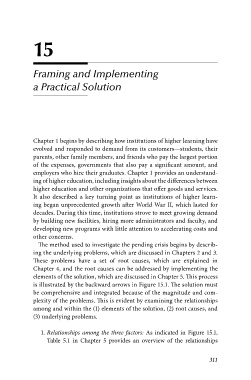Page 341 - Crisis in Higher Education
P. 341
15
Framing and Implementing
a Practical Solution
Chapter 1 begins by describing how institutions of higher learning have
evolved and responded to demand from its customers—students, their
parents, other family members, and friends who pay the largest portion
of the expenses, governments that also pay a significant amount, and
employers who hire their graduates. Chapter 1 provides an understand-
ing of higher education, including insights about the differences between
higher education and other organizations that offer goods and services.
It also described a key turning point as institutions of higher learn-
ing began unprecedented growth after World War II, which lasted for
decades. During this time, institutions strove to meet growing demand
by building new facilities, hiring more administrators and faculty, and
developing new programs with little attention to accelerating costs and
other concerns.
The method used to investigate the pending crisis begins by describ-
ing the underlying problems, which are discussed in Chapters 2 and 3.
These problems have a set of root causes, which are explained in
Chapter 4, and the root causes can be addressed by implementing the
elements of the solution, which are discussed in Chapter 5. This process
is illustrated by the backward arrows in Figure 15.1. The solution must
be comprehensive and integrated because of the magnitude and com-
plexity of the problems. This is evident by examining the relationships
among and within the (1) elements of the solution, (2) root causes, and
(3) underlying problems.
1. Relationships among the three factors: As indicated in Figure 15.1,
Table 5.1 in Chapter 5 provides an overview of the relationships
311

